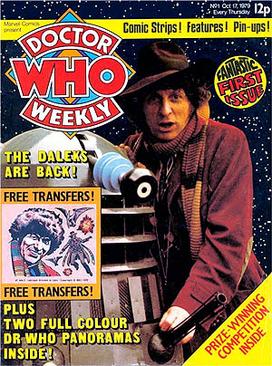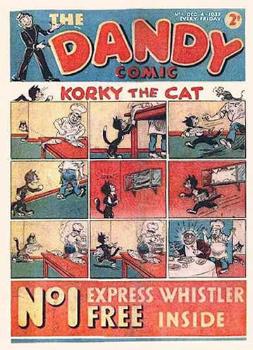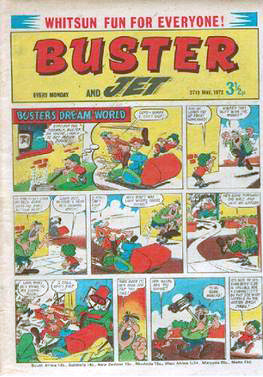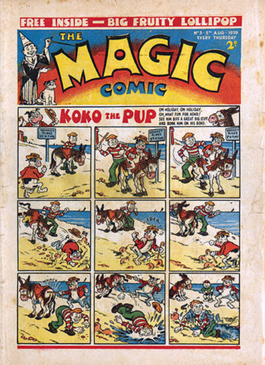
Doctor Who Magazine is a magazine devoted to the British science fiction television series Doctor Who. Launched in 1979 as Doctor Who Weekly, the magazine became a monthly publication the following year. With 13 issues a year, as well as producing triannual deluxe Special Editions (2002–) and Bookazines (2013–), the publication features behind the scenes articles on the TV show and other media, as well as producing its own comic strip. Its founding editor was Dez Skinn, and the longest-serving editor was Tom Spilsbury who served from 2007 to 2017. He was succeeded by Marcus Hearn, who took over from Spilsbury in July 2017. The incumbent editor is Jason Quinn, who took over from Hearn in September 2023. DWM is recognised by Guinness World Records as the longest running TV tie-in magazine, celebrating 40 years of continuous publication on 11 October 2019.

The Dandy was a Scottish children's comic magazine published by the Dundee based publisher DC Thomson. The first issue was printed in December 1937, making it the world's third-longest running comic, after Il Giornalino and Detective Comics. From August 2007 until October 2010, it was rebranded as Dandy Xtreme.

Buster was a British comic which began publication in 1960, originally published by IPC Magazines Ltd under the company's comics division Fleetway, then by Egmont UK Ltd under the same imprint until its closure in 2000. Despite missing issues due to industrial action during its run, the comic published 1,902 issues in total. The comic carried a mixture of humour and adventure strips, featuring the title character Buster and a host of other characters.

Cor!!, a British comic book, was launched in June 1970 by IPC, their sixth new comic in just over a year. Cor!! was edited by Bob Paynter.

Wow! is a British comic book magazine running for 56 issues from 5 June 1982 to 25 June 1983, when it merged with Whoopee!.

Andy Pandy is a British children's television series that aired on BBC Television in 1950. Originally live, a series of 26 filmed programmes was shown until 1970, when a new series of 13 episodes was made. This series was based upon a comic strip of the same name.

Watch with Mother was a cycle of children's programmes created by Freda Lingstrom and Maria Bird. Broadcast by BBC Television from 1952 until 1975, it was the first BBC television series aimed specifically at pre-school children, a development of BBC radio's equivalent Listen with Mother, which had begun two years earlier. In accordance with its intended target audience of pre-school children viewing with their mothers, Watch with Mother was initially broadcast between 3:45 pm and 4:00 pm, post-afternoon nap and before the older children came home from school.
Fred Basset is a comic strip about a male basset hound. The cartoon was created by Scottish cartoonist Alex Graham and published first in the Daily Mail on 8 July 1963.
TV Comic was a British comic book magazine published weekly from 9 November 1951 until 29 June 1984. Featuring stories based on television series running at the time of publication, it was the first British comic to be based around TV programmes; it spawned a host of imitators.
Bertha is a 13-episode British stop motion-animated children's television series about a factory machine of that name that aired from 1985 to 1986. All the characters were designed by Ivor Wood, and the series was produced by his company, Woodland Animations. It was broadcast on BBC Television, It was intended as a replacement to the Postman Pat series, until the second series aired in 1996.

The Magic Comic was a British comics magazine. It was the ill-fated third comics magazine from DC Thomson. It was aimed at a younger audience, with more emphasis on picture stories. The first issue was published on 22 July 1939. The comic ran for only 80 issues until 25 January 1941. Paper rationing resulting from the outbreak of the Second World War caused its demise. Its Editor Bill Powrie promised that 'the Magic' would return; however, he was killed in action in 1942.

Neil the Horse is a comic book character created by Canadian cartoonist Katherine Collins in 1975. Neil is a happy, singing and dancing horse who likes bananas and milkshakes. Neil's adventures were syndicated in Canadian newspapers, published in a comic book series, and adapted for a radio musical.

Kalle Anka & C:o is a Swedish weekly Disney comics magazine, published by Egmont. The 52-page comic, launched in September 1948, is the overall best-selling Swedish comic magazine. In the early years, the comic printed translated stories from the United States, including Walt Disney's Comics and Stories, Four Color and other Dell Comics Disney titles. As Disney comics production waned in the United States in the 1960s, Kalle Anka began printing more European-produced content, from Scandinavia and Italy. Now, Kalle Anka & C:o and its Scandinavian sister editions Anders And & Co. (Denmark) and Donald Duck & Co (Norway) are identical, apart from the language.
Trumptonshire is a fictional county created by Gordon Murray, in which the Trumptonshire Trilogy of Camberwick Green (1966), Trumpton (1967), and Chigley (1969) are located. Trumptonshire is populated by characters portrayed by 8-inch (20 cm) tall stop-motion puppets. Trumpton is a market town with an impressive town hall and clock tower; Camberwick Green and Chigley are two nearby villages.

Sooty is a British children's television media franchise created by Harry Corbett incorporating primarily television and stage shows. The franchise originated with his fictional glove puppet character introduced to television in 1955, with the franchises focused around the adventures of the character – a mute yellow bear with black ears and nose, who is kind-hearted but also cheeky, performs magic tricks and practical jokes, and squirts his handler and other people with his water pistol, including on other television programmes the guest stars on. The franchise itself also includes several other puppet characters who were created for television, some of whom became the backbone to performances, and features additional elements including an animated series, two spin-off series for the direct-to-video market, and a selection of toy merchandising.
Polystyle Publications Ltd was a British publisher of children's comics and books that operated from 1960 to 1997, publishing such titles as TV Comic, I-Spy, Pippin, Countdown/TV Action, and BEEB.
Robin was a British weekly children's magazine published from 1953 to 1969, originally by Hulton Press. Robin was billed as "companion to Eagle, Girl, and Swift" and aimed at younger readers and pre-readers.
Future Generations: Small People was a charity programme for Children in Need, put together by the BBC in 1998 as a sequel of sorts to the great success of the previous year's Perfect Day charity single.










